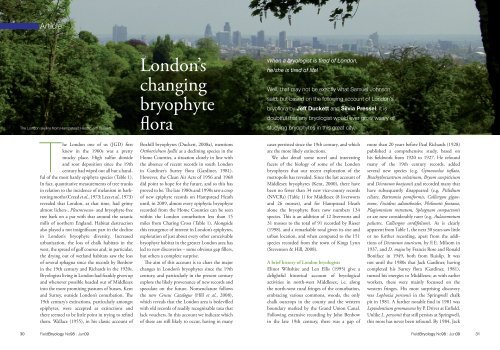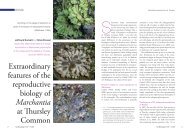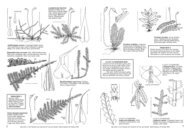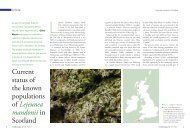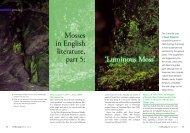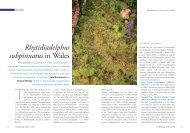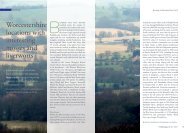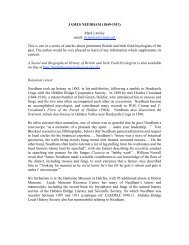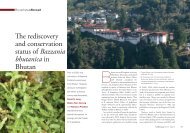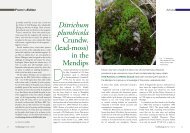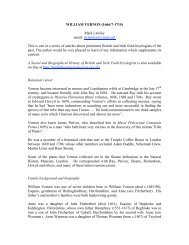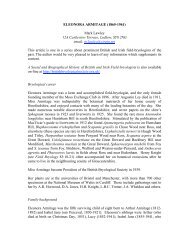London's changing bryophyte flora
London's changing bryophyte flora
London's changing bryophyte flora
Create successful ePaper yourself
Turn your PDF publications into a flip-book with our unique Google optimized e-Paper software.
Article<br />
The London skyline from Hampstead Heath. Jeff Duckett<br />
The London one of us (JGD) first<br />
knew in the 1960s was a pretty<br />
mucky place. High sulfur dioxide<br />
and soot deposition since the 19th<br />
century had wiped out all but a handful<br />
of the most hardy epiphyte species (Table 1).<br />
In fact, quantitative measurements of tree trunks<br />
in relation to the incidence of melanism in barkresting<br />
moths (Creed et al., 1973; Lees et al., 1973)<br />
revealed that London, at that time, had grimy<br />
almost lichen-, Pleurococcus- and <strong>bryophyte</strong>-free<br />
tree bark on a par with that around the satanic<br />
mills of northern England. Habitat destruction<br />
also played a not insignificant part in the decline<br />
in London’s <strong>bryophyte</strong> diversity. Increased<br />
urbanization, the loss of chalk habitats in the<br />
west, the spread of golf courses and, in particular,<br />
the drying out of wetland habitats saw the loss<br />
of several sphagna since the records by Benbow<br />
in the 19th century and Richards in the 1920s.<br />
Bryologists living in London had frankly given up<br />
and whenever possible headed out of Middlesex<br />
into the more promising pastures of Sussex, Kent<br />
and Surrey, outside London’s conurbation. The<br />
19th century’s extinctions, particularly amongst<br />
epiphytes, were accepted as extinctions and<br />
there seemed to be little point in trying to refind<br />
them. Wallace (1955), in his classic account of<br />
London’s<br />
<strong>changing</strong><br />
<strong>bryophyte</strong><br />
<strong>flora</strong><br />
Boxhill <strong>bryophyte</strong>s (Duckett, 2008a), mentions<br />
Orthotrichum lyellii as a declining species in the<br />
Home Counties, a situation closely in line with<br />
the absence of recent records in south London<br />
in Gardiner’s Surrey <strong>flora</strong> (Gardiner, 1981).<br />
However, the Clean Air Acts of 1956 and 1968<br />
did point to hope for the future, and so this has<br />
proved to be. The late 1980s and 1990s saw a crop<br />
of new epiphyte records on Hampstead Heath<br />
until, in 2009, almost every epiphytic <strong>bryophyte</strong><br />
recorded from the Home Counties can be seen<br />
within the London conurbation less than 15<br />
miles from Charing Cross (Table 1). Alongside<br />
this resurgence of interest in London’s epiphytes,<br />
exploration of just about every other conceivable<br />
<strong>bryophyte</strong> habitat in the greater London area has<br />
led to new discoveries – some obvious gap fillers,<br />
but others a complete surprise.<br />
The aim of this account is to chart the major<br />
changes in London’s <strong>bryophyte</strong>s since the 19th<br />
century, and particularly in the present century<br />
explore the likely provenance of new records and<br />
speculate on the future. Nomenclature follows<br />
the new Census Catalogue (Hill et al., 2008),<br />
which reveals that the London area is bedevilled<br />
with old records of readily recognizable taxa that<br />
lack vouchers. In this account we indicate which<br />
of these are still likely to occur, having in many<br />
When a bryologist is tired of London,<br />
he/she is tired of life!<br />
Well, that may not be exactly what Samuel Johnson<br />
said, but based on the following account of London’s<br />
bryo<strong>flora</strong> by Jeff Duckett and Silvia Pressel, it is<br />
doubtful that any bryologist would ever grow weary of<br />
studying <strong>bryophyte</strong>s in this great city.<br />
cases persisted since the 19th century, and which<br />
are the more likely extinctions.<br />
We also detail some novel and interesting<br />
facets of the biology of some of the London<br />
<strong>bryophyte</strong>s that our recent exploration of the<br />
metropolis has revealed. Since the last account of<br />
Middlesex <strong>bryophyte</strong>s (Kent, 2000), there have<br />
been no fewer than 34 new vice-county records<br />
(NVCRs) (Table 1) for Middlesex (8 liverworts<br />
and 26 mosses), and for Hampstead Heath<br />
alone the <strong>bryophyte</strong> <strong>flora</strong> now numbers 134<br />
species. This is an addition of 12 liverworts and<br />
31 mosses to the total of 91 recorded by Rieser<br />
(1998), and a remarkable total given its size and<br />
urban location, and when compared to the 151<br />
species recorded from the town of Kings Lynn<br />
(Stevenson & Hill, 2008).<br />
A brief history of London bryologists<br />
Elinor Wiltshire and Len Ellis (1995) give a<br />
delightful historical account of bryological<br />
activities in north-west Middlesex, i.e. along<br />
the north-west rural fringes of the conurbation,<br />
embracing various commons, woods, the only<br />
chalk outcrops in the county and the western<br />
boundary marked by the Grand Union Canal.<br />
Following extensive recording by John Benbow<br />
in the late 19th century, there was a gap of<br />
more than 20 years before Paul Richards (1928)<br />
published a comprehensive study, based on<br />
his fieldwork from 1920 to 1927. He refound<br />
many of the 19th century records, added<br />
several new species (e.g. Gymnocolea inflata,<br />
Brachytheciastrum velutinum, Bryum caespiticium<br />
and Dicranum bonjeani) and recorded many that<br />
have subsequently disappeared (e.g. Ptilidium<br />
ciliare, Bartramia pomiformis, Calliergon giganteum,<br />
Fissidens adianthoides, Philonotis fontana,<br />
Plagiomnium rostratum, Sphagnum compactum)<br />
or are now considerably rarer (e.g. Aulacomnium<br />
palustre, Calliergon cordifolium). As is clearly<br />
apparent from Table 1, the next 30 years saw little<br />
or no further recording, apart from the additions<br />
of Dicranum tauricum, by F.E. Milsom in<br />
1937, and D. majus by Francis Rose and Ronald<br />
Boniface in 1949, both from Ruislip. It was<br />
not until the 1980s that Jack Gardiner, having<br />
completed his Surrey <strong>flora</strong> (Gardiner, 1981),<br />
turned his energies to Middlesex; as with earlier<br />
workers, these were mainly focussed on the<br />
western fringes. His most surprising discovery<br />
was Lophozia perssonii in the Springwell chalk<br />
pit in 1981. A further notable find in 1981 was<br />
Leptodontium gemmascens by P. Driver at Enfield.<br />
Unlike L. perssonii that still persists at Springwell,<br />
this moss has never been refound. By 1984, Jack<br />
30 FieldBryology No98 | Jun09 FieldBryology No98 | Jun09 31
The <strong>changing</strong> bryo<strong>flora</strong> of London<br />
Table 1. Changes to the epiphytic and rotten wood <strong>bryophyte</strong> <strong>flora</strong> of the London area from the 19th to the 21st century.<br />
NW, north west fringes; C, within the conurbation.<br />
Probable<br />
history<br />
2000–<br />
present<br />
1990–<br />
1999<br />
1980–<br />
1989<br />
1950–<br />
1979<br />
1900–<br />
1949<br />
Species 19th Century<br />
Records<br />
Extinction and<br />
recolonization<br />
Now frequent C &<br />
NW<br />
1983, 9 NW,<br />
1983 C<br />
Frullania dilatata 1862, 1886, 7,<br />
1892–4, 8 all NW<br />
Cololejeunea minutissima 2006, 9 NW New arrival<br />
Lejeunea cavifolia 1894 NW Extinction<br />
Lophocolea semiteres 2009 C New arrival<br />
Microlejeunea ulicina 2005 C<br />
New arrival<br />
2008 NW<br />
Metzgeria consanguinea 1996 NW 2007C New arrival<br />
M. violacea 1996 NW 2007 C New arrival<br />
Nowellia curvifolia 2008 NW New arrival<br />
1926–8 F Extinction but rediscovery<br />
likely<br />
Porella platyphylla 1886,7, 1890, 3, 4<br />
all NW<br />
Extinction and<br />
recolonization<br />
1996 NW 2005 C, now frequent<br />
C & NW<br />
Radula complanata 1861, 9, 1874, 1889,<br />
1891, 3, 4, 7 all NW<br />
2008 NW New arrival or previously<br />
overlooked<br />
1991, 3, 5 all C<br />
1992, 4, 5, 7, all<br />
NW<br />
Bryum moravicum 1980, 2, 4 all<br />
NW<br />
Extinction and<br />
recolonization<br />
1991, 5 all C 2008 NW, now<br />
frequent C & NW<br />
1980, 2, 4 all<br />
NW<br />
Cryphaea heteromalla 1721, 2, 1762, 1863,<br />
1877 all NW<br />
Persistent. No suitable<br />
habitats centrally<br />
1927, 1949 NW 1961 NW 1981–3 NW 1992, 4, 5 all<br />
NW<br />
Dicranum flagellare 1885, 1892, 4 all<br />
NW<br />
D. montanum 1894, 9 NW 1927 NW 1961 NW 1980, 2 NW 1991–5 NW 2005 C Persistent, recent extension<br />
centrally<br />
Persistent, recent extension<br />
centrally<br />
2005 C, now frequent<br />
C & NW<br />
1961 NW 1981, 3 NW 1992, 3, 5, 6<br />
NW<br />
D. tauricum 1937 NW,<br />
(Surrey 1944)<br />
The <strong>changing</strong> bryo<strong>flora</strong> of London<br />
32 FieldBryology No98 | Jun09 FieldBryology No98 | Jun09 33<br />
Persistent as a saxicole,<br />
recent as an epiphyte<br />
Grimmia pulvinata 1989 C 1991 C 2002 C, now frequent<br />
C & NW<br />
Herzogiella seligeri 2009 C New arrival or previously<br />
overlooked<br />
1964 NW Possibly extinct but<br />
rediscovery likely<br />
Homalia trichomanoides 1874, 1886, 1891–3<br />
all NW<br />
Extinction as an epiphyte<br />
followed by recolonization<br />
1992, 4, 7 NW Now frequent C &<br />
NW<br />
1981, 3 NW<br />
1987 C<br />
Orthotrichum affine 1863, 1886, 1894<br />
all NW<br />
Persistent<br />
O. diaphanum 1886, 1892, 4 all NW NW & C NW & C NW & C Now frequent C &<br />
NW<br />
Probable extinction, at least<br />
centrally and recolonization<br />
Now frequent C &<br />
NW<br />
O. lyellii 1841,1894, 6 all NW 1925, 1945 NW 1959 NW 1992, 4, 6 NW<br />
1992 C<br />
New arrival<br />
O. pulchellum 1992 NW 2005 C<br />
2008 NW<br />
O. stramineum 2009 NW New arrival<br />
O. striatum 1989 C 1990, 3, 5 C 2008 C New arrival<br />
Platygyrium repens 2008 NW New arrival<br />
Persistent, recent extension<br />
centrally<br />
2004 C, now frequent<br />
C & NW<br />
1982 NW 1993, 7 NW<br />
1995 C<br />
1950, 2, 9,<br />
1979 all NW<br />
1907, 1922, 3,<br />
1945 all NW<br />
Syntrichia laevipila 1886, 1891, 3, 7 all<br />
NW<br />
2009 C New arrival, one previous<br />
record on wall in 1967<br />
Syntrichia laevipila var.<br />
laevipiliformis<br />
Extinction and<br />
recolonization<br />
2007 C<br />
2008 NW<br />
S. papillosa 1895, 1892, 6 all<br />
NW<br />
Extinction and<br />
recolonization<br />
Now frequent C &<br />
NW<br />
Ulota bruchii 1989 C 1992 NW<br />
1993, 4, 6 C<br />
Extinction and<br />
recolonization<br />
U. crispa 1861 NW 1928 F 1989 C 1992–6 NW Now frequent C &<br />
NW<br />
U. phyllantha 1991 C 2007, 8 NW New arrival?<br />
Zygodon conoideus 2004 C, 2008 NW New arrival?<br />
Persistent as a saxicole,<br />
recent as an epiphyte<br />
2008 NW<br />
2008 C<br />
1993 NW<br />
1994 C, wall<br />
Z. viridissimus 1891, 3, 4 all NW 1927, 1945 NW 1971 NW 1983, 9 NW<br />
masonry
(a) (b) (a) (b) (c)<br />
(c)<br />
n Fig. 1. Saxicolous species. (a) The Bird Bridge, Hampstead Heath.<br />
Crevices in the brickwork harbour Gymnostomum viridulum, whist ivy<br />
in the dell below supports epiphyllic Metzgeria violacea. (b) Entrance<br />
to the Egyptian Avenue, Highgate Cemetery West with Zygodon<br />
rupestris growing on the columns, shown in (c). J.G. Duckett<br />
Gardiner reckoned that the western half of the<br />
county had been fairly well-worked, but that<br />
there was still quite a lot to do in the eastern half,<br />
including Hampstead Heath, and that it would<br />
take another year to complete the county <strong>flora</strong>.<br />
Sadly, his failing health left his dreams unfulfilled<br />
and it was left to succeeding bryologists to<br />
continue the London story. Since Jack’s death in<br />
1989, Elinor Wiltshire has retrod the same paths<br />
as Benbow in the north west, whilst Christine<br />
Rieser and Ken Adams found Hampstead Heath<br />
to be a veritable treasure trove of <strong>bryophyte</strong> biodiversity<br />
(Rieser, 1998).<br />
Saxicolous species<br />
Apart from a rapidly increasing frequency of<br />
Orthotrichum anomalum, Didymodon vinealis,<br />
and Syntrichia intermedia since 2000 [all three<br />
are recorded as rare or local by Kent (2000)],<br />
on gravestones, old walls and masonry in fairly<br />
exposed situations, the most notable additions<br />
to these habitats (typically colonized in London<br />
by Amblystegium serpens, Brachytheciastrum<br />
velutinum, Bryum capillare, B. radiculosum,<br />
Grimmia pulvinata, Hypnum cupressiforme, Rhynchostegium<br />
confertum, Schistidium crassipilum and<br />
Tortula muralis) are O. cupulatum, O. rupestre and<br />
Zygodon viridissimus, and surprisingly the more<br />
typically epiphytic species Z. rupestris (Fig. 1b,<br />
c). The recent records for Homalia trichomanoides<br />
and Anomodon viticulosus are both from an old<br />
concrete wall (Table 1). Porella platyphylla, last<br />
seen in 1961 but without voucher, is also likely<br />
to be found in this habitat, but Pseudocrossidium<br />
revolutum is remarkably uncommon in London.<br />
Given the recent records of Leucodon sciuroides<br />
on walls and tombstones in nearby south-west<br />
Surrey, where it was last seen in 1895, this species<br />
must now be considered as a likely recolonist in<br />
London in the near future. Racomitrium aciculare,<br />
introduced on gritstone boulders used for<br />
landscaping in about 2000, continues to thrive<br />
and produce sporophytes in Mile End Park.<br />
Damp, shaded stonework, including that along<br />
canal banks, was a habitat well-scrutinized by<br />
bryologists at the end of the 20th century. Since<br />
Fred Ambrose found Didymodon umbrosus along<br />
the Grand Union canal at Cowley Lock in 1977,<br />
Jack Gardiner, Monica Milne-Smith and Ken<br />
(f) (g)<br />
n Fig. 2. Light micrographs of Gymnostomum viridulum<br />
(a–e) and Fissidens fontanus (f, g). (a–e) Gemmiferous<br />
protonemata of G. viridulum from Highgate Cemetery<br />
West. (a) Swollen apical cell of an upright chloronemal<br />
filament that will subsequently develop into a gemma.<br />
Abscission cell is arrowed. (b) Gemma with its<br />
abscission cell (arrowed) on the point of rupture. (c)<br />
Scar remaining (arrowed) after gemma liberation. Also<br />
note the elongate abscission cell in the filament on the<br />
right. (d, e) Mature gemmae with pigmented walls and<br />
acuminate apices. (e, f) Fissidens fontanus, Regent’s<br />
Canal, Mile End with the apices of the main rhizoid<br />
axes infected with rostellopsid fungi. Bars, (a–e, g)<br />
50 μm; (f) 100 μm. Silvia Pressel<br />
Adams discovered this species in several other<br />
localities all over London. In contrast, the only<br />
record for Leptobarbula berica in v.-c. 21 remains<br />
that by Jack Gardiner and Monica Milne-Smith<br />
from Hampton Court in 1977, and Gyroweisia<br />
tenuis has only been refound near an old locality<br />
as recently as 2007 (Table 2). Against this<br />
background, it came as a complete surprise when<br />
microscopic examination of similar-looking<br />
plants on damp, shaded stonework and masonry<br />
from Highgate Cemetery West (Fig. 1a) revealed<br />
these to be Gymnostomum viridulum, immediately<br />
recognizable from its highly characteristic protonemal<br />
gemmae (Fig. 2a–e). In contrast to the<br />
gemmae in the vast majority of the Pottiales<br />
examined to date that lack abscission cells<br />
(Duckett et al., 2004), these are a constant<br />
feature of G. viridulum.<br />
The discovery of G. viridulum far outside its<br />
previous British range (Hill et al., 1992) poses<br />
two questions; was it overlooked or is it a recent<br />
arrival, perhaps associated with climate change?<br />
The latter now seems the more likely. Subsequent<br />
to its discovery in Highgate Cemetery West, it has<br />
now been found in several likely ‘Gyroweisia-ish’<br />
spots on Hampstead Heath (Fig. 1a), including<br />
a population with abundant sporophytes in the<br />
Hill Garden. In 2008, it also turned up in the<br />
ornamental garden in Regent’s Park. It is very<br />
unlikely that Elinor Wiltshire overlooked it<br />
when she recorded Didymodon tophacea from the<br />
same place in 1997.<br />
Hard standings and old tarmac in London<br />
have also witnessed major recent changes in their<br />
<strong>bryophyte</strong> <strong>flora</strong>s. These now support what might<br />
best be described as a veritable ‘syntrichietum’<br />
with vigorous swards of Syntrichia montana, S.<br />
ruralis var. ruralis and intermediates with var.<br />
ruraliformis. Also frequent are S. latifolia and<br />
Didymodon nicholsonii, both previously recorded<br />
almost exclusively from riverine habitats. Ken<br />
34 FieldBryology No98 | Jun09 FieldBryology No98 | Jun09 35<br />
(d)<br />
(e)
The <strong>changing</strong> bryo<strong>flora</strong> of London<br />
Table 2. New records for Middlesex (v.-c. 21) since Kent’s <strong>flora</strong> (2000)<br />
Species Habitat Locality Date and recorder Probable origin<br />
Cololejeunea minutissima Epiphyte Harefield Place 2006 J. O’Reilly &<br />
T. Blackstock<br />
Recent arrival<br />
Conocephalum conicum Wall of pond Bushy Park 2008 M.-C. Sheahan Reconfirmation of record<br />
from 1981<br />
Microlejeunea ulicina Epiphyte Trent Country Park 2004 A.J. Harrington Recent arrival<br />
Nowellia curvifolia Decorticated log Stanmore Common 2008 JGD Recent arrival<br />
Lophocolea semiteres Birch tree trunks Hampstead Heath 2009 JGD Recent arrival<br />
Sphaerocarpos michelii Bare soil Hampstead Heath 2000 record collected in<br />
1998 C. Bowlt<br />
Recent arrival<br />
Riccia glauca Arable field Near Harefield 2007 JGD Previously overlooked<br />
R. sorocarpa Arable field Near Harefield 2007 JGD Previously overlooked<br />
Anomodon viticulosus Old concrete wall Moat Mount 2009 JGD & M.-C. Sheahan 1955 record from v.-c. 21<br />
Archidium alternifolium Stony path Hampstead Heath 2006 JGD 1894 record from v.-c. 21<br />
Bryum subapiculatum Bare soil Trent Country Park 2006 A.J. Harrington,<br />
M.-C. Sheahan &<br />
J. Wibraham<br />
Cinclidotus fontinaloides Stonework by<br />
Thames<br />
Ephemerum minutissimum Bare soil Pymme’s Brook,<br />
Southgate<br />
Previously overlooked<br />
Penton Hook 2009 JGD Reconfirmation of previous<br />
records from the 1950s and<br />
1960s<br />
2009 JGD 1919 record from v.-c. 21<br />
Gymnostomum viridulum Damp stonework Highgate Cemetery West 2004 JGD Recent arrival<br />
Gyroweisia tenuis Damp stonework Springwell Lock 2007 JGD 1893 record from v.-c. 21<br />
Homalia trichomanoides Old concrete wall Moat Mount 2009 JGD & M.-C. Sheahan 1926 record from v.-c. 21<br />
Herzogiella seligeri Decorticated log Hampstead Heath 2009 JGD Recent arrival or prevously<br />
overlooked<br />
Isothecium alopecuroides Tree base Church Wood,Trent Park 2006 A.J. Harrington 1927 record from v.-c. 21<br />
Orthotrichum cupulatum Stonework Highgate Cemetery West 2008 JGD & P. Howarth Recent arrival<br />
O. rupestre Stonework Paddington 2004 F.J. Rumsey &<br />
R.C. Porley<br />
Recent arrival<br />
O. stramineum Epiphyte Scratchwood 2009 JGD Recent arrival<br />
Oxyrrhynchium speciosum Tree by water Springwell Lock 2007 JGD 1906 record from v.-c. 21<br />
Phascum cuspidatum var.<br />
schreberianum<br />
Bare soil Gillespie Park, Islington 2008 JGD & P. Howarth Previously overlooked<br />
Platygyrium repens Epiphyte Stanmore Common 2008 JGD Recent arrival<br />
Pleuridium subulatum Bare soil Pymme’s Brook,<br />
Southgate<br />
2009 JGD Dubious old record for v.-c. 21<br />
Pohlia wahlenbergii Gravel path Hampstead Heath 2006 JGD 1923 record from v.-c. 21<br />
Racomitrium aciculare Gritstone<br />
boulders<br />
Mile End Park 2009 JGD and S. Pressel Introduction about 2000<br />
on boulders used for<br />
landscaping<br />
Rhynchostegium<br />
megapolitanum<br />
Adams’ prophecy (Kent, 2000) that S. virescens<br />
might be present in Middlesex but had not yet<br />
been recorded came true with its discovery in<br />
December 2008 on old tarmac in the grounds<br />
of the Orthopaedic Hospital in Stanmore. Since<br />
then, we have found eight additional and seem-<br />
ingly highly unlikely localities in north London,<br />
including the footpath by the A1 at Scratchwood,<br />
Hugo Road in Islington (only 2 miles from Kings<br />
Cross) and in Carlton Square in the East End.<br />
Most recently, it has been found in south London<br />
on old tarmac in Streatham near the main<br />
Brighton road, new to Surrey. Whether or not S.<br />
virescens is a recent arrival in London is an open<br />
question, as is how it gets to new localities since<br />
sporophytes are extremely rare and vegetative<br />
propagules are unknown in Britain, although<br />
the latter have been reported from elsewhere in<br />
Europe (Hill et al., 1992). Since in vitro studies<br />
have revealed the production of asexual propagules<br />
in many mosses where these are unknown<br />
in nature, e.g. several species of Bryum (Pressel et<br />
al., 2007), we are currently cultivating S. virescens<br />
for further study.<br />
Canals and rivers<br />
Unlike all other <strong>bryophyte</strong> habitats in London,<br />
those around the rivers, waterways and canals<br />
The <strong>changing</strong> bryo<strong>flora</strong> of London<br />
Bare ground Gunnersbury 2005 J. O’Reilly 1905 record from v.-c. 21<br />
Syntrichia papillosa Epiphyte Mutton Brook 2006 JGD Recent arrival<br />
S. virescens Old tarmac Orthopaedic Hospital<br />
grounds, Stanmore<br />
Weissia brachycarpa var.<br />
brachycarpa<br />
2008 JGD Recent arrival?<br />
Bare soil Highgate Cemetery West 2008 P. Howarth & JGD Previously overlooked, absence<br />
of suitable habitats<br />
W. longifolia var. longifolia Bare soil Highgate Cemetery West 2008 JGD & P. Howarth Previously overlooked, absence<br />
of suitable habitats<br />
Zygodon conoideus Epiphyte Hampstead Heath 2004 JGD Recent arrival<br />
Z. rupestris Damp stonework Highgate Cemetery West 2005 JGD Recent arrival<br />
have probably witnessed fewer changes from<br />
the 19th century to the present. To date, there<br />
are only three NVCRs from these locations<br />
in the 21st century (Cinclidotus fontinaloides,<br />
Gyroweisa tenuis, Oxyrrhynchium speciosum),<br />
and these simply reconfirmed old records (Table<br />
2). Most species recorded over 100 years ago,<br />
including Didymodon nicholsonii, Fissidens<br />
crassipes, Hygrohypnum luridum, Leskea polycarpa<br />
and Scleropodium cespitans, with the exception<br />
of Dialytrichia mucronata (first recorded in<br />
1981 and still present in 2009), almost certainly<br />
persisted throughout the 20th century but have<br />
gradually increased in abundance and spread<br />
around the canal system into East London<br />
as water quality gradually improved over the<br />
last 20–30 years. A specimen of D. nicholsonii<br />
collected from the Thames at Laleham in 1906<br />
by E.B. Bishop is most remarkable in that it<br />
predates the original description of this species<br />
based on Nicholson’s specimens from Amberley<br />
Wild Brooks in Sussex (Culmann, 1907). Species<br />
either not seen for many years or lacking vouch-<br />
ers are almost certainly waiting to be refound<br />
(e.g. Hygroamblystegium humile, H. varium and<br />
Rhynchostegiella litorea).<br />
The most notable change in the waterside<br />
mosses has been the spread of Fissidens fontanus,<br />
36 FieldBryology No98 | Jun09 FieldBryology No98 | Jun09 37
(a) (b)<br />
n Fig. 3. Canals and rivers. (a) Springwell Lock on the Grand<br />
Union Canal. Fissidens fontanus is abundant below the water,<br />
whilst immediately above it is a continous zone of F. crassipes.<br />
The damp brickwork of the steps supports Gyroweisia tenuis and<br />
Tortula marginata. (b) Riccia fluitans in a pond on the Sandy Heath,<br />
Hampstead. J.G. Duckett<br />
first recorded from the Thames at Shepperton<br />
by Paul Richards and David Catcheside in 1927<br />
and then by Ted Wallace in 1994 in the Grand<br />
Union Canal near Harefield (Fig. 3a). It has now<br />
extended around the canal systems encircling the<br />
north of London and is particularly luxuriant<br />
where the Mile End Road crosses the Regent’s<br />
Canal in the East End.<br />
As to species of open water, Riccia fluitans<br />
(Fig. 3b) is perhaps the most capricious of all<br />
London’s <strong>bryophyte</strong>s, having been variously<br />
found sometimes in great abundance and then<br />
disappearing completely from several ponds and<br />
lakes. In recent years it has been seen regularly<br />
only in ponds on the Sandy Heath, Hampstead,<br />
whereas in 1950 it was abundant in the Viaduct<br />
Pond on the East Heath. Ricciocarpos natans has<br />
been seen but once in the canal at West Drayton<br />
in 1943.<br />
In the Polytrichales, stomatal presence (Polytrichastrum,<br />
Polytrichum) or absence (Pogonatum)<br />
is one of the key characters used for generic<br />
diagnoses (Smith, 2004). We therefore cultivated<br />
F. fontanus in vitro to explore whether or not there<br />
are any protonematal characters, in addition to<br />
the absence of stomata and a central strand in<br />
the stems that might lead to the resurrection<br />
of the genus Octodiceros. Whereas Fissidens<br />
adianthoides, F. bryoides, F. cristatus, F. incurvus,<br />
F. rufulus and F. taxifolius all produce highly<br />
branched, bluntly pointed, non-gemmiferous<br />
chloronemata [see Newton et al. (2000) for an<br />
illustration] both in nature and in culture, the<br />
counterpart in F. fontanus is sparsely branched<br />
with rounded apices. These studies also led us to<br />
a surprising discovery about its rhizoid system in<br />
the wild.<br />
Whenever and wherever we collected F. fontanus<br />
from the Regent’s and Grand Union Canals,<br />
we found the rhizoids to be heavily infected<br />
with parasitic, rostellopsid (chytrid) fungi (Fig.<br />
2f, g), only previously recorded sporadically from<br />
a handful of other mosses (Martinez-Abaigar et<br />
al., 2005). Examination of numerous herbarium<br />
specimens of F. fontanus from other localities,<br />
not only in Britain (the Oxford canal, the Severn<br />
in Shropshire and the River Dee in Chester)<br />
but also as far afield as rivers in Lesotho and the<br />
Nile in Egypt, revealed the invariable presence<br />
of this fungus. Widening our investigation, we<br />
found no trace of the fungus in collections of<br />
Fissidens crassipes, F. rufulus, F. adianthoides and<br />
F. monguillonii, except for its sporadic occurrence<br />
in Platyhypnidium riparioides but never in Leptodictyum<br />
riparium growing with it. The galls in<br />
F. fontanus also bear an uncanny resemblance<br />
to the brown spherical gemmae described from<br />
a population of Dialytrichia mucronata from the<br />
Golan Heights in Israel (Hernstadt & Heyn,<br />
2004). The illustration of one of these at the<br />
tip of a long, unbranched rhizoid indicates that<br />
they are almost certainly rostellopsid galls. These<br />
are absent from our British collections of D.<br />
mucronata and those of Cinclidotus fontinaloides,<br />
except for one from along Bow Brook, a tributary<br />
of the Avon at Peopleton in Worcestershire. In<br />
2005, Howard Matcham also found similar<br />
infections in a D. mucronata collection from<br />
a stone gutter at Westbourne Church, near<br />
Havant, South Hampshire. The occurrence of<br />
rostellopsids in D. mucronata, F. fontanus and<br />
Platyhypnidium invites further studies as these<br />
may provide a most sinister explanation for<br />
the widely reported decimation of amphibians<br />
in Britain and worldwide by chytridiomycosis<br />
(Beard & O’Neill, 2005). On the one hand,<br />
molecular studies may demonstrate whether<br />
the moss-rhizoid parasite and the amphibian<br />
killer are one and the same fungus; on the other,<br />
experimental studies are needed to see if the<br />
rhizoid fungus leads to disease in amphibians.<br />
Bogs and heathland<br />
These are the habitats that have suffered most<br />
from habitat destruction, and many species lost<br />
from localities in the London area are probably<br />
permanent extinctions. Though experience dictates<br />
that speculation about what might occur<br />
in the future is often proved wrong, it would<br />
appear unlikely that the following liverworts will<br />
reappear; Blasia pusilla (Hounslow Heath 19th<br />
century), Odontoschisma sphagni (Hampstead<br />
Heath, 1832), Ptilidium ciliare (Stanmore Common,<br />
1925) and Trichocolea tomentella (Queen’s<br />
Wood, Highgate, 1700). For the following<br />
<strong>bryophyte</strong>s, however, it would seem only a<br />
matter of time before they turn up again;<br />
Nardia scalaris (Harrow Weald, 1982, but without<br />
voucher), Bartramia pomiformis and Brachythecium<br />
glareosum (Springwell, 1950 and 1951),<br />
Calliergon giganteum (Stanmore Marsh, 1922),<br />
The <strong>changing</strong> bryo<strong>flora</strong> of London<br />
Campylophyllum calcareum and Campylium<br />
stellatum (both Harefield, 1896), C. protensum<br />
(Ruislip and Stanmore Commons, 1920s),<br />
Climacium dendroides (Swakeleys Park, 1893),<br />
Hylocomium splendens (Ruislip, 1927), Oxyrrhynchium<br />
schleicheri (Springwell, 1951, but<br />
without voucher), Pogonatum nanum and P.<br />
urnigerum (Harrow Weald, 1922 and 1907,<br />
respectively), Rhodobryum roseum (Hampstead<br />
Heath, 1832), Rhytidiadelphus loreus (Ruislip,<br />
1895), R. triquetrus (Harefield, 1894), Straminergon<br />
stramineum (Harefield area, 1922) and<br />
Taxiphyllum wissgrillii (Springwell, 1955, but<br />
without voucher).<br />
On the positive side, six species of Sphagnum<br />
continue to flourish in two sites on Hampstead<br />
Heath, just as they did when described by<br />
Christine Rieser (1998), although whether all<br />
these got there by natural means is clouded<br />
by the wilful introduction into the bog west<br />
of Kenwood, by one of the gardening staff, of<br />
unidentified species from the New Forest to<br />
boost the Hampstead population. Growing with<br />
the sphagna in this bog, Ken Adams, in 1993,<br />
found London’s then only known population of<br />
Pellia neesiana. The fact that these plants were all<br />
female, and still are today, led Ken to suggest that<br />
they might have arisen from a single spore (Kent,<br />
2000). The presence of female plants alone has<br />
also added to nagging doubts about the status of<br />
this P. neesiana population. Was it inadvertently<br />
introduced from the New Forest along with<br />
the sphagna? The discovery of a second large<br />
population of P. neesiana, but this time male, by<br />
Peter Howarth and JGD in 2008 in the swamp<br />
around inflow to the Stock Pond some 400 m<br />
from the Kenwood bog indicates that P. neesiana<br />
is almost certainly native. The other London<br />
Sphagnum populations in the north west around<br />
Harefield, Harrow Weald, Ruislip and Stanmore<br />
(Richards, 1928) have become much depleted<br />
38 FieldBryology No98 | Jun09 FieldBryology No98 | Jun09 39
The <strong>changing</strong> bryo<strong>flora</strong> of London<br />
since the 1920s, and over the years Middlesex has<br />
lost S. capillifolium subsp. rubellum, S. subnitens<br />
var. subnitens, S. compactum and S. inundatum,<br />
although new recent records of S. fallax and S.<br />
palustre from Loxley Green Local Nature Reserve<br />
(the Borough of Barnet’s only bog) are welcome<br />
additions. The two best-known southern hemi-<br />
sphere introductions into Britain – Campylopus<br />
introflexus, first recorded in Sussex in 1941, in<br />
Surrey in 1952 and in Middlesex at Mill Hill in<br />
1962, and Orthodontium lineare, first recorded<br />
in Yorkshire in 1920, in Surrey on Farnham<br />
Common in 1940 and in Middlesex on Harrow<br />
Weald Common in 1951 – both spread rapidly<br />
throughout London both north and south of the<br />
Thames to occupy virtually all suitable habitats<br />
by the early 1960s.<br />
Terrestrial habitats; bare soil<br />
Perhaps the most striking change in the terrestrial<br />
<strong>flora</strong> of London has been the spread of<br />
, Fig. 4. Terrestrial habitats; bare soil. (a) Hennediella macrophylla,<br />
Hampstead Heath Extension. (b) Sphaerocarpos michelii, Gillespie<br />
Park Local Nature Reserve, near Kings Cross. J.G. Duckett<br />
(a) (b)<br />
Hennediella macrophylla (Fig. 4a) since the<br />
first record by, who else other than Harold<br />
Whitehouse, along the river Crane in 1968.<br />
Since then it has been found not only in riverine<br />
locations, but also on hard-packed soil on paths<br />
and in flower beds and shrubberies in parks<br />
throughout London both north and south of the<br />
Thames, exactly the same habitats as in its type<br />
locality in the Botanic Gardens of the University<br />
of Canterbury, Christchurch, New Zealand.<br />
Stevenson & Hill (2008) suggest that the<br />
patchy distribution of H. macrophylla in King’s<br />
Lynn probably reflects the fact that this likely<br />
introduction from the southern hemisphere<br />
(Hill et al., 1991) is still spreading in Britain.<br />
In London it now occupies all suitable niches.<br />
Perhaps one of the more surprising additions<br />
to London’s <strong>bryophyte</strong>s was the discovery of<br />
Sphaerocarpos michelii growing on broken ground<br />
by a car park below Pryors Field on Hampstead<br />
Heath. Since then it has been found by pteridol-<br />
ogist John Edgington (Edgington, 2003) along<br />
a path on an otherwise totally unremarkable area<br />
of amenity grass by Shadwell station in the East<br />
End, and by Peter Howarth in Gillespie Park<br />
Nature Reserve (Fig. 4b) within a stone’s throw<br />
of Kings Cross.<br />
The absence of typical arable field taxa from<br />
the Middlesex list, noted by Ken Adams in Kent<br />
(2000) as likely to occur, simply reflects a rare and<br />
declining habitat with more and more pastures<br />
given over to horses. The fact that our first visit<br />
to an arable field near Harefield (in 2007) resulted<br />
in records for the usual suspects Riccia glauca<br />
and R. sorocarpa, and that a recent survey of<br />
Waterfall Walk, Southgate, turned up Ephemerum<br />
minutissimum and Pleuridium subulatum<br />
indicates that further forays will add other taxa<br />
not seen for many years, e.g. Acaulon muticum<br />
(New Years Green, 1926), Microbryum davallianum<br />
(Ruislip Common, 1925) and Tortula<br />
lanceolata (Ruislip, 1965, but without voucher).<br />
The paucity of arable fields notwithstanding,<br />
ephemeral Pottiaceae are perplexingly underrepresented<br />
in London. Paradoxically, some less<br />
common arable taxa have turned up in urban<br />
sites near to Central London; in 2008, Weissia<br />
brachycarpa var. brachycarpa and W. longifolia<br />
var. longifolia were found in quantity on a newly<br />
cleared bank in Highgate Cemetery West and<br />
Phascum cuspidatum var. schreberianum in the<br />
Gillespie Park Nature Reserve near Kings Cross.<br />
In vitro cultivation of this taxon alongside var.<br />
piliferum and type P. cuspidatum indicates that<br />
all three are clearly distinct and thus their status<br />
probably requires re-evaluation.<br />
The discovery of Riccia cavernosa at Ruislip<br />
Lido in 1993, and several bare mud localities<br />
for Aphanoregma patens suggests that this habitat<br />
could well produce other taxa new to London.<br />
Apart from the very restricted occurrence of<br />
the Riccia spp., the only other complex thalloid<br />
liverwort that is common in London is Lunularia<br />
cruciata. Marchantia polymorpha (always var.<br />
ruderalis), recorded after WWII as abundant on<br />
bombed sites (Kent, 2000) is now known from<br />
The <strong>changing</strong> bryo<strong>flora</strong> of London<br />
but a handful of ‘natural sites’ in parks and on<br />
a dripping wall in Stepney Green underground<br />
station, other than its sporadic appearance in<br />
greenhouses and garden centres.<br />
Epiphytes<br />
The data summarized in Table 2 demonstrates<br />
incontrovertibly that epiphytic <strong>bryophyte</strong>s have<br />
increased dramatically in the London area since<br />
the 1980s. Apart from Lejeunea cavifolia and<br />
Homalia trichomanoides that are very likely to be<br />
refound, the only other long-term and almost<br />
certainly permanent extinctions are probably<br />
Frullania tamarisci (Hampstead Heath, 1830),<br />
Antitrichia curtipendula (Enfield Chase, 1741)<br />
and Pterygonium gracile (on beech, Enfield<br />
Chase, 1762). In addition to the species listed<br />
in Table 2 whose distributions have undergone<br />
marked changes can be added persistent species.<br />
These are Cephalozia bicuspidata, Lepidozia<br />
reptans, Lophocolea heterophylla, Metzgeria<br />
furcata, Amblystegium serpens, Aulacomnium<br />
androgynum, Brachytheciastrum rutabulum, B.<br />
velutinum, Bryum capillare, Dicranoweisia cirrata,<br />
Homalothecium sericeum, Hypnum cupressiforme,<br />
Isothecium myosuroides, Rhynchostegium confertum<br />
and Tetraphis pellucida. The influx of new species<br />
seems to have had little effect on the abundance<br />
of these pollution-resistant stayers with the<br />
exception of Tetraphis and Orthodontium. Back<br />
in the dirty days of the 1960s, these were the<br />
only mosses commonly found at the bases of<br />
oaks; today they have been replaced by Hypnum<br />
andoi and Isothecium myosuroides, with Tetraphis<br />
and Orthodontium now mainly confined<br />
to birch trunks and dead wood, the latter often<br />
with large areas of gemmiferous protonemata<br />
(Duckett et al., 2001). As to the last habitat, the<br />
distribution of Dicranum flagellare has largely<br />
remained unchanged and is limited by the availability<br />
of old hornbeam coppice stools, whilst<br />
40 FieldBryology No98 | Jun09 FieldBryology No98 | Jun09 41
(5a) (6a) (6c)<br />
(5b)<br />
The <strong>changing</strong> bryo<strong>flora</strong> of London The <strong>changing</strong> bryo<strong>flora</strong> of London<br />
n Fig. 5. Epiphytes. (a) Sloping ash trunk at Moat Mount with a fine<br />
colony of Frullania dilatata and tufts of Ulota bruchii, U. crispa and<br />
U. phyllantha (b). J.G. Duckett<br />
D. montanum has spread onto the trunks of<br />
living trees. D. tauricum is now frequent on a<br />
variety of both dead and living trees in woodlands<br />
throughout the London area (Fig. 6c).<br />
The recent discovery of Nowellia curvifolia on<br />
a decorticated log on Stanmore Common is<br />
matched by Ken Adams finding it recently in<br />
Epping Forest. Similarly, it was only a matter of<br />
time before Lophocolea semiteres was discovered<br />
on Hampstead Heath in 2009 given its abundance<br />
in Epping Forest to the east and in Surrey<br />
to the south-west of London.<br />
JGD still remembers Jack Gardiner’s delight<br />
when, in 1983, Frullania dilatata was found for<br />
(6b)<br />
the first time in the 20th century in Middlesex<br />
in Ruislip Woods (Gardiner & Bowlt, 1983).<br />
Today, it is common in sheltered wooded areas<br />
throughout the London area (Fig. 5a), as are<br />
Orthotrichum lyellii (Fig. 6b), Ulota bruchii, U.<br />
crispa and Cryphaea heteromalla, the last species<br />
almost always with numerous sporophytes and<br />
often forming patches over 10 cm in diameter.<br />
Ulota phyllantha is also frequent at three sites<br />
(Hampstead Heath, Bentley Priory and Moat<br />
Mount) on sloping turkey oak, ash and willow<br />
trunks (Fig. 5a). There are fewer records from<br />
south of the river, but sightings of all five species<br />
in the last 4 years on Barnes Common, and in<br />
Dulwich Park and Crystal Palace Park, indicate<br />
centripetal spreading since Jack Gardiner’s 1981<br />
Surrey <strong>flora</strong>, like that seen in Middlesex. In fact,<br />
Jack in 1981 noted a decrease in Cryphaea since<br />
Ted Wallace described it as occurring all along<br />
the (North) Downs in 1941 (Wallace, 1941); in<br />
1981 it had very few extant localities and those<br />
were all restricted to the far south of Surrey. Since<br />
it was first recorded as an epiphyte on Hampstead<br />
Heath in the 1990s Grimmia pulvinata has<br />
become widespread on a variety of trees in the<br />
London area. Radula complanata, found for<br />
the first time on Hampstead Heath by Alan<br />
Harrington in 2005, is also increasing, but not<br />
quite as dramatically as Metzgeria consanguinea<br />
and M. violacea. It is now common at Stanmore,<br />
Loxley Green, Scratchwood and on Hampstead<br />
Heath to see these two species, together with<br />
another rapidly spreading new arrival, Zygodon<br />
conoideus, completely clothing sallow branches<br />
v Fig. 6. Epiphytes. (a) Sallows in the grounds<br />
of Stanmore Orthopaedic Hospital with trunks<br />
covered with Zygodon conoideus and patches of<br />
Radula complanata. (b) Highly tomentose colony<br />
of Orthotrichum lyellii at Scratchwood. (c) Sloping<br />
birch, Sandy Heath, Hampstead covered with<br />
Dicranum tauricum, D. montanum, Dicranoweisia<br />
cirrata, Hypnum andoi, Lophocolea heterophylla<br />
and L. semiteres. (d) Moss-covered bole at the base<br />
of a Prunus in Hugo Road, Tufnell Park. (e) A close<br />
up view showing Syntrichia papillosa growing with<br />
Orthotrichum diaphanum and Grimmia pulvinata, now<br />
a common epiphyte on a variety of trees in London.<br />
J.G. Duckett<br />
and trunks (Fig. 6a). Such a vast increase in<br />
abundance is probably the consequence of a<br />
series of wet summers, as is the unusual sight<br />
of M. violacea growing as an epiphyll on ivy on<br />
Hampstead Heath (Duckett, 2008b).<br />
An interesting feature of the two Metzgeria<br />
species is that, unlike the exogenous gemmae<br />
in most leafy liverworts (Duckett & Ligrone,<br />
1995), these are endogenous in origin (Ligrone<br />
& Duckett, 1993). This is a novel morphological<br />
feature that supports the most recent totalevidence<br />
liverwort phylogenies that closely<br />
link Metzgeria with the Aneuraceae (Forrest et<br />
al., 2006; Crandall-Stotler et al., 2008). The<br />
pale colour of the thalli of Riccardia incurvata,<br />
illustrated here for comparison with Metzgeria<br />
(Fig. 7a–d), is due to most of the upper surface<br />
of mature thalli being made up of the empty<br />
cell walls remaining after gemma liberation.<br />
The multicellular foliar gemmae in Radula are<br />
also endogenous in origin but, considering the<br />
near-crown group position of the Radulaceae,<br />
this is almost certainly a derived feature in<br />
the Jungermanniidae. In gemmiferous Radula,<br />
portions of the leaf margins are also caducous.<br />
On the theme of asexual reproduction<br />
Zygodon conoideus, Orthotrichum affine (see<br />
Goode et al., 1993 for a full description) and<br />
42 FieldBryology No98 | Jun09 FieldBryology No98 | Jun09 43<br />
(6d)<br />
(6e)
The <strong>changing</strong> bryo<strong>flora</strong> of London<br />
, Fig. 7. Scanning electron micrographs [see<br />
Duckett & Ligrone (1995) for preparative methods].<br />
(a–d) Formation of endogenous gemmae in<br />
Metzgeria violacea (a, b) and Riccardia incurvata<br />
(c, d), an important character linking the<br />
Metzgeriaceae and the Aneuraceae. Note the<br />
pits remaining in the thalli after gemma liberation.<br />
In (d) the original outer walls of the thallus are<br />
peeling off (arrowed) exposing the gemmae below.<br />
(e, f) Gemmiferous protonemata of Orthotrichum<br />
affine (e) and O. diaphanum (f). Broken walls of the<br />
abscission cells of liberated gemmae are arrowed.<br />
Bars, 50 μm. J.G. Duckett<br />
(a)<br />
(e)<br />
(b)<br />
(f)<br />
O. diaphanum can all be found in London as<br />
extensive patches, often up to 10 cm in diameter,<br />
comprising gemmiferous protonemata bearing<br />
only scattered rudimentary gametophores (Fig.<br />
7e, f). Those of the latter species are readily<br />
distinguished by their dark red coloration.<br />
In contrast, in O. lyellii, the Orthotrichum<br />
producing the most copious foliar gemmae,<br />
gemmiferous protonema is hard to find even in<br />
highly tomentose colonies (Fig. 6b), and these<br />
are absent in the other orthotricha.<br />
(c)<br />
(d)<br />
Considering the recent increase in Syntrichia<br />
papillosa across southern England, it was only a<br />
matter of time before it turned up in London.<br />
Following the first record (Mutton Brook<br />
alongside the North Circular Road), it has<br />
now been found by Peter Howarth along the<br />
Woodland Walk, a disused railway line running<br />
from Highgate to Finsbury Park, on Stanmore<br />
Common and forming large tufts alongside S.<br />
laevipila on the swollen root boles of grafted<br />
Prunus in Hugo Road, Tufnell Park (Fig. 6d, e).<br />
As in rural Surrey (Gardiner, 1981), S. laevipila<br />
var. laevipiliformis appears to be scarce in<br />
London.<br />
Though most new arrivals have been<br />
increasingly found in other localities, e.g.<br />
Cololejeunea minutissima, Microlejeunea ulicina,<br />
Orthotrichum pulchellum and Ulota phyllantha,<br />
Orthotrichum striatum remains restricted to<br />
Hampstead Heath. For the future it will be<br />
interesting to see whether the same will also<br />
prove to be the case for Platygyrium repens,<br />
recently found (2008) on a sloping ash trunk<br />
on Stanmore Common. P. repens was first found<br />
in Surrey, east of Chiddingford, well outside<br />
London by Brian O’Shea and JGD in 1969 on<br />
an excursion led by Ted Wallace. This was one<br />
of the very few occasions when Ted became<br />
distinctly ruffled that someone else had got an<br />
NVCR in his beloved county! Since the original<br />
record, P. repens has turned up in only three other<br />
Surrey localities, all well outside London.<br />
Perhaps the clearest sign yet that London<br />
trees now are a good place for epiphytes was<br />
our discovery in 2009 of Frullania dilatata,<br />
Orthotrichum lyellii, Ulota crispa and Zygodon<br />
viridissimus on sloping ash trunks in Mile End<br />
Cemetery within the sound of Bow Bells and<br />
deep in Jack the Ripper and Kray Twin territory,<br />
once considered the grimmest part of the capital<br />
on every count.<br />
Jeffrey G. Duckett & Silvia Pressel<br />
School of Biological and Chemical Sciences,<br />
Fogg Building, Queen Mary University of<br />
London, Mile End Road, London E1 4NS (e j.g.<br />
duckett@qmul.ac.uk; s.pressel@qmul.ac.uk)<br />
Acknowledgments<br />
We dedicate this article to Ted Wallace and Jack Gardiner<br />
with happy memories of many days of field bryology in the<br />
1960s and 70s together with Brian O’Shea, Monica Milne-<br />
Smith and Joyce Smith, not to mention Wendy Gardiner’s<br />
macaroni cheese suppers washed down with much whisky in<br />
Jack’s house at Lancaster Gate following the excursions! We<br />
thank Ken Adams, Alan Harrington and Peter Howarth for<br />
making available their records of London <strong>bryophyte</strong>s, Howard<br />
Matcham for drawing on his remarkable knowledge of moss<br />
biology, Mary-Clare Sheahan for her critical reading of the<br />
manuscript and Karen Renzaglia and the staff at the Imaging<br />
Center, Southern Illinois University for electron microscope<br />
facilities. Silvia Pressel acknowledges the financial support of a<br />
Leverhulme Trust Early Career Fellowship. Without the kind<br />
permission of Mrs Jean Pateman and the Friends of Highgate<br />
Cemetery that allowed Peter Howarth and JGD to explore<br />
the West Cemetery, the five NVCRs from there would have<br />
remained undetected.<br />
44 FieldBryology No98 | Jun09 FieldBryology No98 | Jun09 45<br />
References<br />
The <strong>changing</strong> bryo<strong>flora</strong> of London<br />
Beard, K.H. & O’Neill, E.M. (2005). Infection of an<br />
invasive frog Eleutherodactylus coqui by the chytrid fungus<br />
Batrachochytrium dendrobatidis in Hawaii. Biological<br />
Conservation 126, 591–595.<br />
Crandall-Stotler, B., Stotler, R.E. & Long, D.G. (2008).<br />
Morphology and classification of the Marchantiophyta.<br />
In Bryophyte Biology, 2nd edn, pp. 1–54. Edited by A.J.<br />
Shaw & B. Goffinet. Cambridge: Cambridge University<br />
Press.<br />
Creed, E.R., Lees, D.R. & Duckett, J.G. (1973). Biological<br />
method of estimating smoke and sulphur dioxide pollution.<br />
Nature 244, 278–280.<br />
Culmann, O. (1907). Barbula aut Didymodon nicholsoni, sp.<br />
nova. Revue Bryologique 34, 100–102.<br />
Duckett, J. G. (2008a). Gathering moss at Boxhill. In London’s<br />
Changing Natural History. Classic papers from 150 years of<br />
the London Natural History Society, pp. 75–76, Edited by<br />
M. Burgess. Oxford: London Natural History Society.
The <strong>changing</strong> bryo<strong>flora</strong> of London<br />
Duckett, J.G. (2008b). Epiphyllous and epifungal liverworts<br />
on Hampstead Heath. Field Bryology 95, 8–10.<br />
Duckett, J.G. & Ligrone, R. (1995). The formation of<br />
catenate gemmae and the origin of oil bodies in the liverwort<br />
Odontoschisma denudatum (Mart.) Dum. (Jungermanniales):<br />
a light and electron microscope study. Annals of Botany 76,<br />
405–419.<br />
Duckett, J.G., Goode, J.A. & Matcham, H.W. (2001).<br />
Studies of protonemal morphogenesis in mosses. VIII.<br />
The gemmiferous protonemata of Dicranoweisia and<br />
Orthodontium. Journal of Bryology 23, 181–194.<br />
Duckett, J.G., Fletcher, P., Francis, R., Matcham, H.W.,<br />
Read, J.T., Russell, A.J. & Pressel, S. (2004). In vitro<br />
cultivation of <strong>bryophyte</strong>s; practicalities, progress, problems<br />
and promise. Journal of Bryology 26, 3–20.<br />
Edgington, J.A. (2003). Ferns of the Metropolis – a status<br />
report. London Naturalist 82, 59–73.<br />
Forrest, L.L., Davies, E.C., Long, D.G. Crandall-Stotler, B.J.,<br />
Clark, A. & Hollingsworth, M.L. (2006). Unravelling the<br />
evolutionary history of the liverworts (Marchantiophyta):<br />
multiple taxa, genomes and analyses. Bryologist 109, 303–<br />
334.<br />
Gardiner, J.C. (1981). A <strong>bryophyte</strong> <strong>flora</strong> of Surrey. Journal of<br />
Bryology 11, 747–841.<br />
Gardiner, J.C. & Bowlt, C. (1983). A survey of the <strong>bryophyte</strong>s<br />
of Ruislip Woods. Journal of the Ruislip District Natural<br />
History Society 24, 12–23.<br />
Goode, J.A., Stead, A.D. & Duckett, J.G. (1993). Studies<br />
of protonemal morphogenesis in mosses II. Orthotrichum<br />
obtusifolium Brid. Journal of Bryology 17, 409–419.<br />
Hernstadt, I. & Heyn, C.C. (2004). Bryopsida (Mosses). In<br />
The Bryophyte Flora of Israel and Adjacent Regions, pp. 13–<br />
520. Edited by C. Heyn & I. Hernstadt. Jerusalem: Israel<br />
Academy of Sciences and Humanities.<br />
Hill, M.O., Preston, C.D. & Smith, A.J.E. (editors) (1991).<br />
Atlas of the Bryophytes of Britain and Ireland, Vol. 1. Liverworts.<br />
Colchester: Harley Books.<br />
Hill, M.O., Preston, C.D. & Smith, A.J.E. (editors) (1992).<br />
Atlas of the Bryophytes of Britain and Ireland, Vol. 2. Mosses<br />
(except Diplolepideae). Colchester: Harley Books.<br />
46 FieldBryology No98 | Jun09<br />
Hill, M.O., Blackstock, T.H., Long, D.G. & Rothero, G.P.<br />
(2008). A Checklist and Census Catalogue of British and Irish<br />
Bryophytes. Updated 2008. Middlewich: British Bryological<br />
Society.<br />
Kent, D.H. (2000). Flora of Middlesex. A Supplement to the<br />
Historical Flora of Middlesex. Woking: Gresham Press.<br />
Lees, D.R., Creed, E.R. & Duckett, J.G. (1973). Atmospheric<br />
pollution and industrial melanism. Heredity 30, 227–232.<br />
Ligrone, R. & Duckett, J.G. (1993). Formation of engogenous<br />
gemmae in simple thalloid liverworts, Metzgeria and<br />
Riccardia (Metzgeriales). Giornale Botanico Italiano 17,<br />
74–76.<br />
Martinez-Abaigar, J., Nunez-Olivera, E., Matcham, H.W. &<br />
Duckett, J.G. (2005). Interactions between parasitic fungi<br />
and mosses: pegged and swollen-tipped rhizoids in Bryum<br />
and Funaria. Journal of Bryology 27, 47–53.<br />
Newton, A.E., Cox, C.J., Duckett, J.G., Wheeler, J.A.,<br />
Goffinet, B. & Mischler, B.D. (2000). Evolution of major<br />
moss lineages: phylogenetic analyses bases on multiple gene<br />
sequences and morphology. Bryologist 103, 187–211.<br />
Pressel, S., Matcham, H.W. & Duckett, J.G. (2007). Studies<br />
of protonemal morphogenesis in mosses. XI. Bryum and<br />
related genera; a plethora of propagules. Journal of Bryology<br />
29, 241–258.<br />
Richards, P.W. (1928). Ecological notes on the <strong>bryophyte</strong>s of<br />
Middlesex. Journal of Ecology 16, 268–300.<br />
Rieser, C. (1998). Hampstead Heath survey progress report<br />
for 1997. Mosses and liverworts. London Naturalist 77,<br />
191–197.<br />
Smith, A.J.E. (2004). The Moss Flora of Britain and Ireland,<br />
2nd edn. Cambridge: Cambridge University Press.<br />
Stevenson, C.R. & Hill, M.O. (2008). Urban myths exploded:<br />
results of a bryological survey of King’s Lynn (Norfolk, UK).<br />
Journal of Bryology 30, 12–22.<br />
Wallace, E.C. (1941). The mosses of Surrey. Journal of Botany,<br />
London 79, 1–11 and 17–25.<br />
Wallace, E.C. (1955). The <strong>bryophyte</strong>s of Boxhill. London<br />
Naturalist 34, 147–153.<br />
Wiltshire, E. & Ellis, L.T. (1995). John Benbow (1821–<br />
1908) and the <strong>bryophyte</strong>s of north-west Middlesex. London<br />
Naturalist 74, 21–53.


